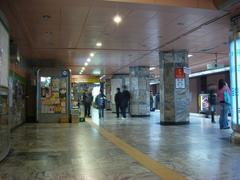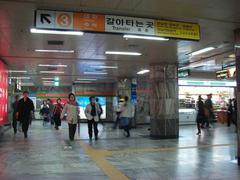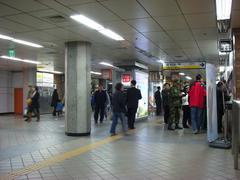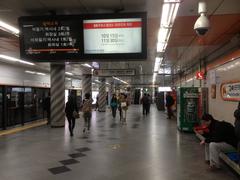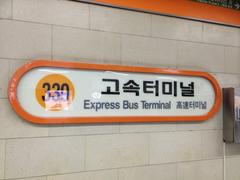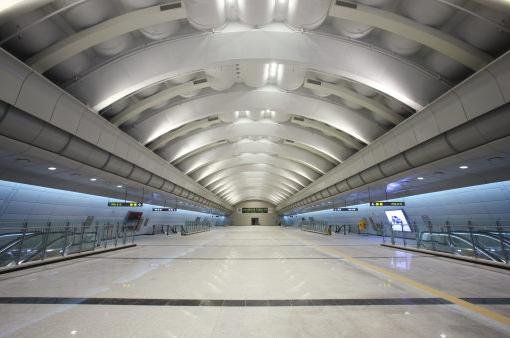
Express Bus Terminal Station Seoul: Visiting Hours, Tickets, and Travel Guide
Date: 14/06/2025
Introduction
Seoul’s Express Bus Terminal Station (고속터미널역) stands as a vital transportation hub and urban landmark, reflecting South Korea’s rapid modernization and innovative city planning. Established in the early 1980s to meet growing intercity travel demand, the terminal was strategically located in Gangnam to balance the city’s development and centralize the country’s express bus network. Today, it serves as a key nexus, connecting nearly 60 cities nationwide via express bus routes and integrating three major subway lines (Lines 3, 7, and 9).
Beyond transportation, the station’s mixed-use design incorporates expansive commercial, leisure, and accommodation facilities, notably the Central City complex and the renowned GOTO Mall underground shopping center. This comprehensive guide explores the station’s history, architectural importance, travel services, amenities, and surrounding attractions—offering essential insights for both commuters and tourists. For more on its origins and urban role, visit Seoul Metropolitan Government and Wikipedia.
Contents
- Origins and Development
- Architectural and Urban Significance
- Role in the National Transportation Network
- Visiting Hours and Ticketing
- Accessibility and Travel Tips
- Nearby Attractions and Shopping
- Urban Connectivity
- Influence on Urban Planning and Future Prospects
- FAQ
- Plan Your Visit
Origins and Development
The Express Bus Terminal Station is a product of South Korea’s urbanization in the late 20th century. With the opening of the Gyeongin Expressway in 1969, demand for intercity travel surged, prompting the need for a centralized terminal (Seoul Metropolitan Government). In 1981, the terminal opened in Banpo-dong, Seocho-gu, as the largest bus station in Asia, featuring an innovative multi-story design that streamlined passenger flow and set new standards for Korean transportation infrastructure.
Strategically placed in Gangnam, the terminal played a crucial role in balancing Seoul’s urban growth across the Han River, transforming patterns of movement and commerce in the city. It quickly became the primary hub for buses on the Gyeongbu, Guma, and Yeongdong expressways, connecting Seoul to major cities nationwide.
Architectural and Urban Significance
Express Bus Terminal Station is a prominent part of Seoul’s urban landscape and a pioneering example of integrated development. The complex connects directly to subway Lines 3, 7, and 9, making it one of the busiest and most important transfer stations in Seoul (Wikipedia). The facility consists of two main buildings: the original terminal (serving Gyeongbu and Yeongdong lines) and the Central City terminal, which also houses the Honam line and is integrated with the Central City complex (Seoul Suburban).
Central City is a landmark in mixed-use urban development, featuring the Shinsegae Department Store, JW Marriott Hotel, Millennium Hall, banks, clinics, and a large parking area (Wikipedia). This model of integrating transportation with commerce and leisure has influenced urban projects throughout Korea.
Role in the National Transportation Network
As the largest and most important bus terminal in South Korea, Express Bus Terminal serves as the primary gateway for intercity and express buses to and from Seoul (Wikipedia – Seoul Express Bus Terminal). It connects to nearly 60 cities, supports over 60 local bus routes, and offers direct airport limousine services to major airports (Wikipedia). The terminal’s capacity and efficiency have democratized intercity travel, centralizing operations for convenience and reliability (Seoul Metropolitan Government).
The terminal’s uniformed staff, including drivers and attendants, have become cultural icons, symbolizing the modernization of Korean society.
Visiting Hours and Ticketing Information
- Terminal and Subway: Open daily from ~5:00 AM to midnight (specific bus companies may vary slightly; subway service generally runs 5:30 AM–midnight) (official Seoul transport sites).
- Ticketing: Express bus tickets are sold at staffed counters, automated kiosks, and online platforms such as Kobus. Subway tickets and T-money cards are available at ticket machines and convenience stores.
- Tip: Arrive at least 30 minutes before bus departures for ticketing and boarding.
Accessibility and Travel Tips
Express Bus Terminal Station is fully accessible, featuring elevators, tactile paving, and accessible restrooms. Multilingual signage (Korean, English, Chinese, Japanese) makes navigation straightforward for international visitors (Klook). Travelers are encouraged to review station maps (available online and on-site) and utilize multiple exits for efficient access to buses, malls, and nearby streets.
For added convenience, download the Audiala app for real-time transit updates and navigation.
Nearby Attractions and Shopping
- GOTO Mall (Gangnam Terminal Underground Shopping Center): Seoul’s largest underground mall, featuring 600+ stores for fashion, cosmetics, and home goods (KoreaToDo).
- Central City Complex: Home to the Shinsegae Department Store, JW Marriott Hotel, World Food Court, bookstores, and specialty shops.
- Banpo Hangang Park: Famous for its rainbow fountain, riverside views, and recreational spaces.
- Seoul Arts Center: Major venue for music and arts performances.
- Famille Station: Trendy lifestyle complex with cafes and dining.
Urban Connectivity
The station’s triple-line subway integration (Lines 3, 7, and 9) provides seamless access to key districts across Seoul (Wikipedia). Numerous city bus stops and taxi stands are located nearby, along Sinbanpo-ro, Banpo-daero, and Sapyeong-daero, linking the terminal to major destinations like the Han River parks and Seoul Arts Center (Namu Wiki).
Influence on Urban Planning and Future Prospects
Express Bus Terminal Station has served as a model for integrated urban complexes in Korea. Its influence is evident in subsequent projects that combine transportation, shopping, and leisure. Ongoing modernization—including digital upgrades and high-capacity WiFi—ensures the station remains at the forefront of Seoul’s urban development (Wikipedia).
Station Layout and Facilities
Multi-Line Connectivity:
The station serves as an interchange for Lines 3, 7, and 9, each on a separate underground level. Over 14 exits connect to the Central City complex, bus terminal, GOTO Mall, and adjacent streets (ExploreMetro).
Key Facilities:
- Ticket Counters & Machines: For both subway and bus services; multilingual support available (Creatrip).
- Luggage Services: Coin-operated lockers and bus luggage handling.
- Shopping & Dining: From GOTO Mall’s affordable fashion to Shinsegae’s luxury boutiques and a diverse food court.
- Rest Areas: Waiting lounges in the terminal and hotel access via JW Marriott (Klook).
- Accessibility: Elevators, escalators, and accessible restrooms throughout.
- Connectivity: Free WiFi, mobile charging stations.
- Safety: CCTV, lost & found, emergency services.
Practical Travel Tips
- Arrive early during weekends and holidays for bus travel.
- Use information desks for navigation and assistance.
- Avoid peak hours (weekday mornings 7–9 AM, evenings 5–7:30 PM) for more comfort.
- Use T-money cards for subway travel and consider online booking for bus tickets.
Frequently Asked Questions (FAQ)
Q: What are the Express Bus Terminal Station visiting hours?
A: Subway operates from 5:30 AM to midnight. Bus ticket counters and shopping areas generally run 10:00 AM–10:00 PM.
Q: How do I purchase tickets?
A: Buy subway tickets or T-money cards at machines or convenience stores; express bus tickets at counters, machines, or online (Kobus).
Q: Is the station wheelchair accessible?
A: Yes. Elevators, ramps, and accessible restrooms are available.
Q: Are there direct airport buses?
A: Yes. Limousine buses to Incheon and Gimpo airports depart frequently from the terminal.
Q: What nearby attractions can I visit?
A: Banpo Hangang Park, GOTO Mall, Seoul Arts Center, and various shopping/dining complexes.
Related Attractions: Banpo Bridge and Gyeongbokgung Palace
Banpo Bridge (반포대교) & Rainbow Fountain
Overview:
Banpo Bridge, completed in 1982, is renowned for the Rainbow Fountain—the world’s longest bridge fountain, with multicolored LED-lit water shows synchronized to music.
Fountain Show Schedule:
Operates April–October, evenings 8:00–10:00 PM, shows every 30 minutes (check Visit Seoul for the latest schedule).
Admission:
Free. Best viewing at Banpo Hangang Park, accessible from Express Bus Terminal Station.
Nearby Attractions:
Goto Mall, Shinsegae Department Store, Seorae Village, Seoul Arts Center, and riverside parks (KoreaToDo).
Accessibility:
Wheelchair-friendly paths and facilities are provided.
Gyeongbokgung Palace (경복궁)
Overview:
The main royal palace of the Joseon Dynasty, built in 1395, now restored as a premier historical and cultural attraction.
Visiting Hours:
Open daily 9:00 AM–6:00 PM (closed Tuesdays). Last admission 5:00 PM.
Tickets:
Adults 3,000 KRW; discounts for youths/seniors. Combined tickets available for museums.
Getting There:
Gyeongbokgung Station (Line 3, Exit 5), or by bus/taxi.
Accessibility:
Wheelchair-accessible paths, restrooms, and assistance services.
Highlights:
Changing of the Guard, Hyangwonjeong Pavilion, Secret Garden, and special events.
Nearby:
Bukchon Hanok Village, Insadong, Cheonggyecheon Stream.
Official Website:
Gyeongbokgung Palace
Conclusion
Express Bus Terminal Station is more than just a transportation hub—it exemplifies Seoul’s dynamic spirit by seamlessly blending efficient transit, shopping, dining, and cultural experiences. With its strategic location, extensive facilities, and proximity to popular attractions like Banpo Hangang Park and Central City, it is an essential gateway for exploring Seoul and beyond. Use digital tools and official resources to plan your journey, and make the most of your visit by exploring the vibrant neighborhood and nearby landmarks.
For travel updates and personalized guides, download the Audiala app and follow us for more Seoul travel tips.
Sources and Official Links
- Seoul Metropolitan Government: Express Bus Terminal Guide
- Wikipedia: Express Bus Terminal Station
- ExploreMetro: Express Bus Terminal Station Visitor Guide
- KoreaToDo: Must-Visit Places in Seoul
- Klook: Express Bus Terminal Station
- Creatrip: Korea Transportation Guide
- Kobus: Express Bus Tickets
- Seoul Suburban: Express Bus Terminal Station
- Namu Wiki: Express Bus Terminal Station
- Official Seoul Tourism – Banpo Bridge Fountain Show
- Gyeongbokgung Palace Official Website

